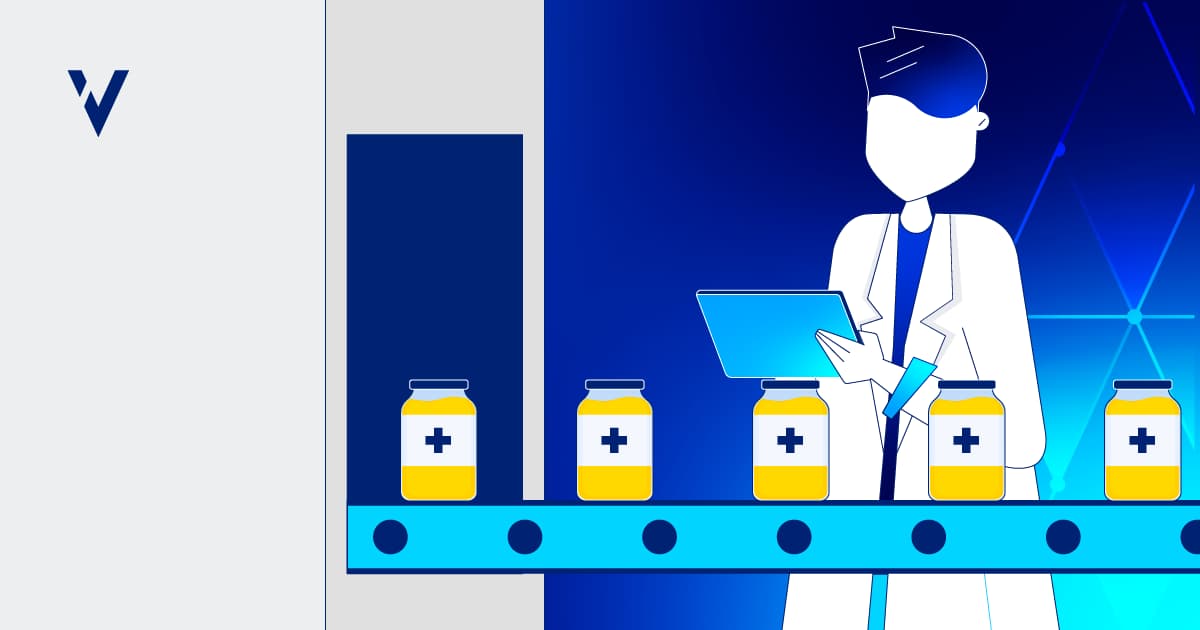In our recent Industry Insight, “Better Tech Transfers: A Digital Transformation Approach,” we explored the strategies contract development and manufacturing organizations (CDMOs) are adopting to enhance their operations.
In this blog post, we delve into how these advancements align with Pharma 4.0 principles, marking the next evolutionary phase of the pharmaceutical industry. By integrating advanced digital tools and methodologies, CDMOs are not only improving efficiency and competitiveness but also embracing a holistic, data-driven approach at the core of Pharma 4.0. This synergy underscores the transformative potential of digital innovation in shaping the future of pharmaceutical manufacturing.
The Pillars of the Pharma 4.0 Landscape
Pharma 4.0 is a comprehensive manufacturing approach derived from Industry 4.0, introduced in 2017 by the International Society for Pharmaceutical Engineering (ISPE).
It integrates advanced digital technologies such as artificial intelligence (AI), Internet of Things (IoT), and big data analytics using smart machines. This approach epitomizes the integration of technology into the pharmaceutical industry to optimize manufacturing processes through digitalization, resulting in new levels of connectivity, transparency, flexibility, efficiency, responsiveness, and productivity. Pharma 4.0 simplifies compliance, achieves cost savings, reduces downtime and waste, and fosters innovation.
Pharma 4.0 is built on nine key pillars, categorized into three main areas: technology, digitalization, and skills. Each pillar represents a digital technology that manufacturers should adopt to improve their processes. Together, these technologies enable companies to implement smart production, optimize operations, enhance product quality, and accelerate time-to-market for new medicines.

Figure 1 – Representation of the 9 pillars of Pharma 4.0 action plan into 3 main areas: Technology, Digitalization, and Skills.
A. Technology
Big Data Analytics: Automation and digitalization generate vast amounts of data during manufacturing. Big data analytics processes and analyzes these large data sets to extract insights that optimize the manufacturing process.
Industrial Internet of Things (IoT): IoT devices, equipped with sensors and software, monitor and control various aspects of the manufacturing process.
Autonomous Systems: Robotics and automation minimize human intervention, leading to fewer errors and greater efficiency in manufacturing.
B. Digitalization
Cloud-Based Computing and Storage: Cloud computing allows pharmaceutical companies to store and manage various data types, serving as the foundation for AI, machine learning (ML), and IoT. Cloud storage is secured with cybersecurity measures to prevent unauthorized access.
Artificial Intelligence and Machine Learning: AI algorithms analyze data from IoT devices and other sources to detect patterns and trends, enhancing manufacturing processes and product quality.
Cybersecurity: Protecting critical data from cybersecurity risks is essential due to increased connectivity and standard communication protocols.
C. Skills
Horizontal and Vertical Integration: Full integration of IT systems across organizations, customers, and suppliers leads to automated value chains.
Augmented Reality: Augmented reality systems, though still in the early stages, provide functionalities such as repair instructions via mobile devices, enhancing decision-making processes, and optimizing work procedures.
Advanced Manufacturing: Techniques like 3D printing are useful for manufacturing small batches of customized products, enhancing performance, or creating lightweight designs.
Technology Transfer—Synergy with Digital Tools
The implementation of digital tools in the pharmaceutical industry optimizes processes, ensuring consistent and accurate execution of transferred processes. AI-driven data integration, knowledge management, and risk assessment streamline the transfer process, minimizing risks and ensuring regulatory compliance.
Successful Pharma 4.0 implementations leverage digital toolboxes that enhance mathematical algorithms through AI and ML, process monitoring, and optimization tools. Among the many benefits, consider the following:

Figure 2 — Competitive advantages for technology transfer leveraged by synergy with digital tools.
Process Design and Scale-Up
Digital tools leveraging ML algorithms uncover optimal processing parameters for scale-up processes, reducing development time and minimizing waste.
Enhanced Knowledge Management
Tech transfers involve complex data migrations, which can lead to issues like data loss and retrieval difficulties due to connection failures and lack of structure. Effective data management is crucial, and incremental migration helps mitigate risks.
During tech transfer, several challenges arise:
- Data Collection Completion: Initial product development generates vast amounts of data requiring meticulous recording and effective management to avoid underutilization and missed insights.
- Data Accuracy and Integrity: Ensuring data accuracy and integrity through robust recording methods and verification processes is essential.
- Structuring and Retrieving Data: Properly organizing data is vital for accessibility and utility. In complex fields like pharmaceuticals, planning data collection and organization strategies is critical.
Maintaining data integrity is paramount. Artificial intelligence and ML play key roles in detecting anomalies, ensuring accuracy, and analyzing large datasets to identify patterns, thus strengthening data integrity throughout the pharmaceutical lifecycle.
AI-Enabled Risk-Based Approaches
AI processes complex data quickly and accurately, making it ideal for real-time risk assessment and decision-making. Automated risk assessments simplify procedures by identifying correlations and relationships, providing continuous surveillance, and reducing biases in risk interpretation.
Advanced Control Strategy
Digital tools develop advanced process controls by predicting manufacturing trajectories using real-time sensor data combined with AI methods. Predictive maintenance analytics anticipate equipment malfunctions, enhancing efficiency and reducing waste.
Blockchain Technology
Blockchain technology improves drug safety, reduces counterfeiting, enhances supply chain efficiency, and ensures regulatory compliance. It relies on veracity, transparency, independence, and security to ensure certified, publicly accessible, and cryptography-protected transactions. Blockchain can store data from IoT sensors, facilitating real-time decision-making and creating predictive models for pharmaceutical cold chain risks.
Trend Detection
Artificial intelligence is integral to digital toolboxes, identifying and analyzing clusters of problem areas to prioritize continuous improvement. It excels at pinpointing trends related to manufacturing deviations, helping to understand root causes. Artificial intelligence models and expert systems predict optimal values for complex variables, optimizing formulations or processes.
Digital tools scrutinize deviation reports, enabling more accurate and efficient data analysis, even with extensive textual content. They help initiate maintenance actions when equipment performance deviates, reducing process downtime. Consequently, businesses can proactively adapt strategies and stay ahead of the competition.
Key Considerations for Investing in Digital Tools for Tech Transfer
Major players in the pharmaceutical industry are investing in digital tools, necessitating a paradigm shift in mindset and significant investment in new technologies, infrastructure, specialized IT frameworks, and innovative corporate strategies.
Digital tools have the potential to reduce costs, drive treatment innovation, and enhance patient outcomes. Implementing these tools is not only feasible but represents the future of the industry. Early adopters will gain a competitive edge as standards, strategies, and ecosystems evolve. Prioritizing user experience during implementation is essential.
In regulated sectors like drug development and manufacturing, digital data points undergo rigorous audits. Use cases must be meticulously defined, verified, validated, and completely transparent.
Before investing in digital tools, take the following steps:
- Identify and Empower Advocates: Encourage digital transformation advocates within your organization to explore potential applications and foster enthusiasm.
- Cultivate Relationships: Establish partnerships with research labs, academic institutions, technology providers, application developers, and start-ups within the digital toolbox ecosystem.
- Prioritize Use Cases: Focus on small-scale Proof of Value (PoV) investments that offer business and process insights. Consider therapeutic focus areas, business strategy, customer value propositions, and future growth plans. Monitor and scale up effective PoV initiatives.
Integrating the Pharma 4.0 operating model into your digital strategy is crucial. Every business opportunity should be evaluated through the lens of analytics. Embracing this cultural and mindset shift will create a data-driven organization capable of swiftly recognizing, validating, and capitalizing on opportunities.
The implementation of digital tools offers numerous advantages, including:
- Holistic Control Strategy: Automated digitalization and validation ensure compliance with ICH (International Council for Harmonization) Q10 pharmaceutical quality system (PQS) guidelines, enhancing knowledge and quality risk management.
- Manufacturing Optimization: Streamlined workflows save time and money, reducing manufacturing costs and ensuring data integrity.
- Workforce Benefits: Improved working conditions lead to higher performance, reduced stress, and increased engagement.
Effective Tech Transfers with ValGenesis
Integrating digital tools into tech transfer processes within the Pharma 4.0 initiative offers numerous advantages, from manufacturing optimization to workforce benefits.
By adopting digital tools and a data-driven approach, organizations can gain a competitive edge in the pharmaceutical industry, ensuring better patient outcomes and streamlined operations. As standards and ecosystems evolve, early adopters of digital transformation will be better positioned to lead the way in the future.

ValGenesis Consulting Services improve tech transfer operations by leveraging our deep industry expertise and advanced tools. We align traditional tech transfer principles with robust risk management and data-driven approaches, such as process modeling and advanced data science. This methodology ensures efficient and compliant technology transfer across the product lifecycle, preventing development bottlenecks and facilitating smoother, faster market transitions.
We also use digital solutions designed to streamline qualification and validation processes, enhance data integrity, and ensure regulatory compliance.
These solutions include:
- ValGenesis Validation Lifecycle Management System (VLMS): A centralized platform for managing qualification and validation activities.
- ValGenesis iRisk: Enhances quality risk management by optimizing risk identification and mitigation.
- ValGenesis Process Insight: Provides process performance monitoring and predictive analytics, efficiently structuring data for comparability between sites.
- ValGenesis e-Logbook: Enhances knowledge management by digitizing and centralizing all GMP logs, making data entry precise, secure, and easily accessible.
These capabilities, combined with user-friendly dashboards, are essential for maintaining consistent product quality and improving tech transfer processes within the Pharma 4.0 framework.
To explore how these solutions can transform your tech transfer processes, read the full Industry Insight document, "Better Tech Transfers: A Digital Transformation Approach." For personalized guidance, reach out to one of our experts.



